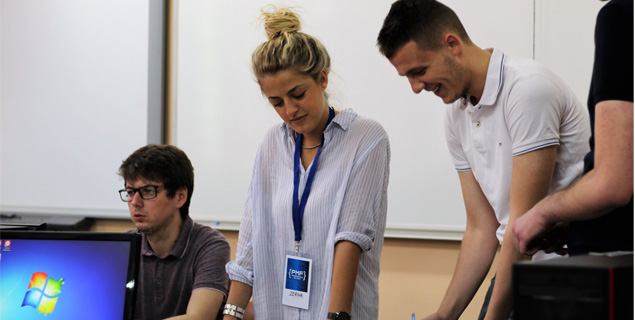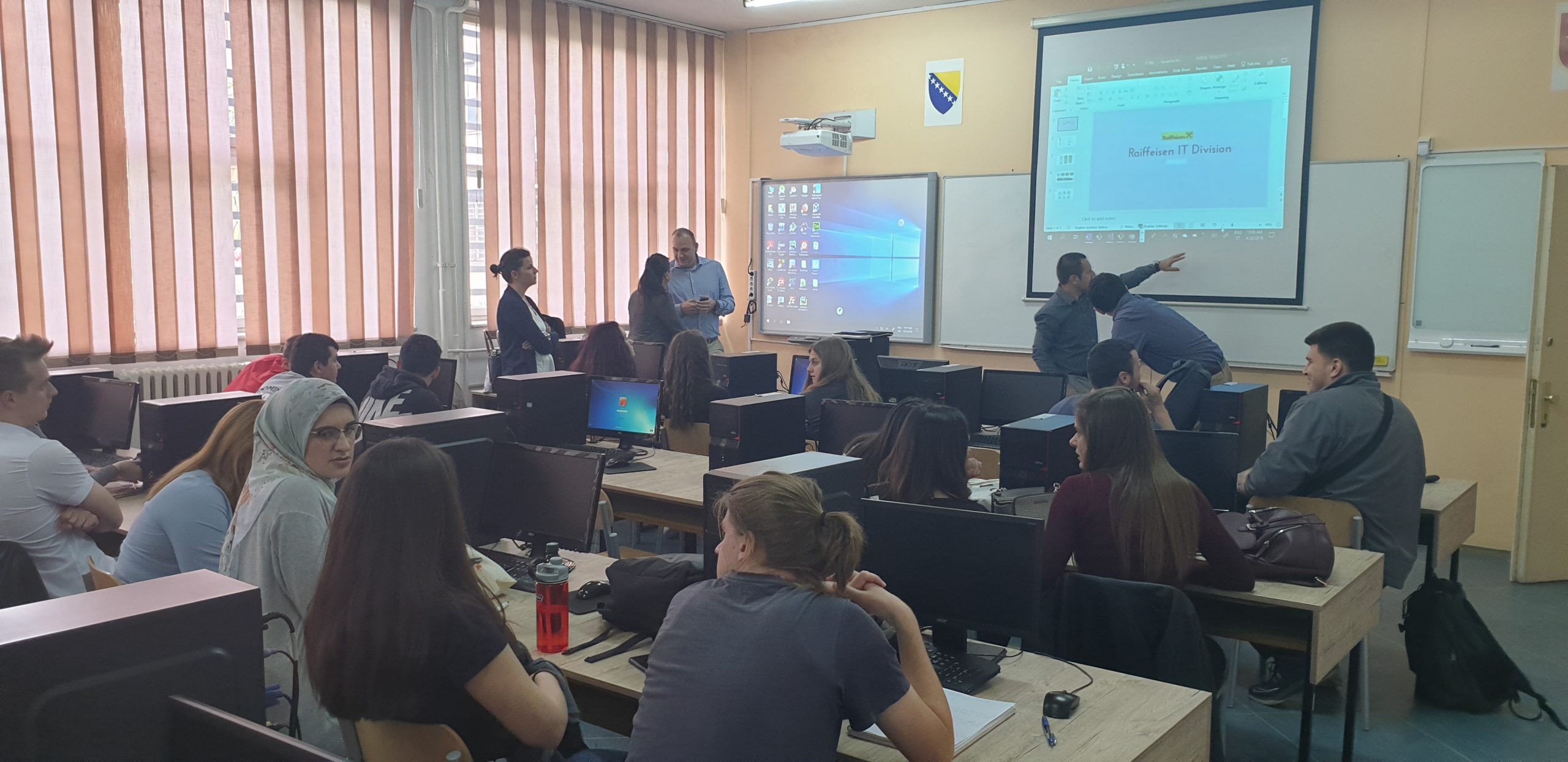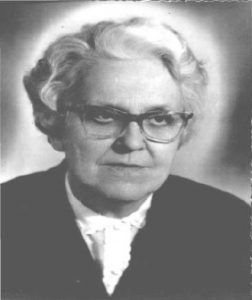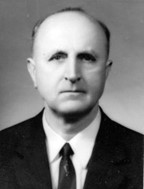Historical development of the Department of Mathematics
As part of the Department of Science and Mathematics of the Faculty of Philosophy, mathematics is included in the XI group of subjects, while physics or philosophy could be chosen as the second subject.
With the academic year 1960/1961. In 2010, the Faculty of Science and Mathematics was separated from the Faculty of Philosophy and the Department of Mathematics was part of it. Professor Vera Šnajder was appointed as the first head of the Department.
The study of mathematics was initially intended for the education of professors of mathematics, which was the only thing possible under the conditions of the time. With the development of technologies and the need for the application of mathematics, along with the development of our own personnel, the education of mathematicians has been differentiated.

At the Department of Mathematics, according to the Statute from 1966, the following groups of sciences were studied:
- I-1. Mathematics – general direction
- I-2. Mathematics with physics – general direction
- I-3. Mathematics with design geometry – teacher's course
- I-4. Mathematics with physics – teaching major
- Mathematics with physics – I degree
Upon completion of studies, the following titles were acquired:
- I-1. Mathematics – general major – graduate mathematician
- I-2. Mathematics with physics – general major – graduate mathematician
- I-3. Mathematics with design geometry – teacher's course – professor of mathematics
- I-4. Mathematics with physics – teaching major – professor of mathematics
- Mathematics with physics – I level – mathematics teacher
The Department had the following chairs:
- Department of Mathematical Analysis and Algebra
- Department of Geometry
- Department of Numerical Mathematics and Mathematical Statistics

In addition, the Institute of Mathematics of the Faculty of Science Sarajevo is starting to operate.
Academic 1966/67. year at the Department of Mathematics, there were also organized classes at the postgraduate level. This study was launched every other year.
Since 1971, the Institute of Mathematics of the Faculty of Science Sarajevo has been abolished.
The following groups of subjects could be studied at the Department of Mathematics:
- Group I-1. Mathematics – general course,
- Group I-2. Mathematics – teaching major.
Where the following professional titles could be acquired:
- Group I-1. Mathematics – general major – graduate mathematician,
- Group I-2. Mathematics – teaching major – professor of mathematics.
The Department had the following chairs and cabinets:
- Department of Mathematical Analysis and Algebra
- Department of Geometry
- Department of General Mathematics
- Cabinet for numerical mathematics and mathematical statistics
- Cabinet for elementary mathematics and mathematics teaching methodology
Since 1979, the following majors and groups of sciences could be studied at the Department of Mathematics, and there were certain chairs and offices.
Since 1979, the following majors and groups of sciences could be studied at the Department of Mathematics:
for obtaining a higher professional qualification:
- Mathematics – teaching major,
for obtaining a higher professional qualification:
- Mathematics – teaching major,
- Mathematics – general direction of applied mathematics,
- Mathematics – general direction of theoretical mathematics.
Where the following professional titles could be acquired:
- Mathematics – teaching major – 1st degree – mathematics teacher,
- Mathematics – teaching major – professor of mathematics,
- Mathematics – general course of applied mathematics – graduate mathematician,
- Mathematics – general course of theoretical mathematics – graduate mathematician.
The Department has the following chairs and offices:
- Department of Mathematical Analysis,
- Department of Algebra and Geometry,
- Department of General and Applied Mathematics,
- Cabinet for numerical mathematics and computer programming,
- Cabinet for mathematics teaching methodology,
- Administrative-librarian service.
As part of the plan for the general course of applied mathematics, the courses Programming and programming languages and Data theory are being introduced for the first time.
The Department of Mathematics within the Faculty of Science continuously performed its teaching and scientific mission during the war years 1992-1995. year
From the academic year 1991/92. In 2010, studies at the Department of Mathematics were organized in the following way:
Undergraduate studies – eight semesters
- general major (graduated in mathematics)
- teaching major (professor of mathematics)
- mathematics and theoretical computer science (mathematician with a degree in computer science)
First degree – four semesters
- mathematics and informatics (teacher of mathematics and informatics)
mathematics and physics (teacher of mathematics and physics).
The Department has the following chairs and offices:
- Department of Algebra and Geometry
- Department of Analysis
- Department of Probability and Statistics
- Department of Numerical and Applied Mathematics
- Department of Theoretical Computer Science
- Cabinet for mathematics and informatics teaching methodology
- Institute for Applied Mathematics and Informatics
- Computing center
From the academic year 2005/06. year study at the Department of Mathematics is organized according to the 3+2+3 system in accordance with the Bologna system of studies, which means that all students attend the mandatory three years of the first cycle of study, and after successful completion, they obtain a corresponding diploma (depending on the chosen course).
After that, you can optionally attend two more years of studies of the II study cycle, the successful completion of which brings an additional diploma of a higher rank.
Students who complete the first and second cycles of studies can enroll in the third cycle, which lasts three years (six semesters), and upon successful completion, a corresponding title is obtained depending on the chosen field of research.
In the first cycle of studies, which lasts three years, the student can opt for one of the following courses:
- general direction
- applied mathematics
- theoretical computer science
- teaching major (mathematics)
- teaching major (mathematics and informatics)
Upon successful completion of the three-year study, the student acquires the following titles, depending on the chosen major (listed in the same order as in the presentation of majors and study groups):
- baccalaureate/bachelor of mathematics
- baccalaureate/bachelor of mathematics
- baccalaureate/bachelor of software engineering
- baccalaureate/bachelor of mathematics
- bachelor's degree in mathematics and computer science
Od akademske 2008/2009. godine, Odsjek za matematiku je započeo realizaciju nastave II ciklusa studija (master), koji traje dvije godine, a student se može opredijeliti za jedan od slijedeća četiri smjera:
- opći smjer
- primijenjene matematike
- teorijske kompjuterske nauke
- nastavnički smjer
Po uspješnom završetku II ciklusa studija, student stječe sljedeća zvanja, ovisno o izabranom smjeru (navedeno u istom redoslijedu kao i u prikazu smjerova i studijskih grupa):
- magistar matematike
- magistar primijenjene matematike
- magistar softverskog inžinjerstva
- magistar matematike
The Department of Mathematics offers the following doctoral studies (III study cycles):
- joint doctoral study of Natural and Mathematical Sciences in Education, study program Mathematics in Education – launched in the academic year 2013/2014. years
- Doctoral study of mathematical sciences in Southeastern Europe (in English and Bosnian) – started in the academic year 2010/2011. year
Upon completion of the joint doctoral study of natural and mathematical sciences in education, the study program of mathematics in education, the title is obtained
Doctor of Mathematical Sciences in Education.
Upon completion of the Doctoral Study in Mathematical Sciences in Southeast Europe, one of the following two titles is obtained:
- doctor of mathematical sciences,
- doctor of computer science,
depending on the chosen field of research.
Biographies of prominent people

Vera Šnajder was born on February 2, 1904, in Reljevo, near Sarajevo, in the family of a university rector. She died on February 14, 1976, in Sarajevo. She finished elementary school and classical high school in Sarajevo in 1922. She enrolled at the Faculty of Philosophy in Belgrade – a group of applied mathematics, theoretical mathematics, and experimental physics for the academic year 1922/23. years. Due to an interruption caused by a serious illness, she finished her studies in 1928. From the end of his studies until November 1929. she was a teacher at the Women's Gymnasium in Sarajevo, when, as one of the best students of her generation and a promising young mathematician, she received a scholarship from the French government and went to Paris for training.
Thus, Vera Šnajder in the academic year 1929/30. spends the year at the famous “Henri Poincaré” Institute in Paris, where he participates in work of seminars. Since she stood out with special results, she received and accepted an offer to work as a part-time associate in the Hydrodynamics Laboratory at the Sorbonne. He remained at that job until the end of 1932 when he returned to Sarajevo. During her study stay in Paris, Vera Šnajder published her first scientific paper in the Comptes Rendus des Sciences de l'Académie des Sciences, which was also the first scientific paper in the field of mathematics published by an author born in Bosnia and Herzegovina. Some of her experimental results were later presented at an exhibition in Paris. In addition, there is a document from which it can be seen that during her stay in Paris, Vera Schneider was also offered an engagement for the needs of the French Air Ministry.
Upon her return from Paris, at the end of 1932, Vera Šnajder returned to her position as a teacher at the Women's Gymnasium in Sarajevo, where she enjoyed great authority, both among her students and their parents, and among her colleagues. As an advanced intellectual, she belonged to the circle of left-oriented Sarajevo intellectuals together with her husband Dr. Marcel Šnajder, one of the first doctors of philosophy in Bosnia and Herzegovina, otherwise, a professor of philosophy and mathematics.
After liberation, in June 1945, she was appointed director of the Second Girls’ High School, and in March 1946. becomes one of the first professors of the Higher Pedagogical School in Sarajevo. November 1947. she was appointed as an advisor in the Ministry of Education of the Republic of Bosnia and Herzegovina, where she works tirelessly to restore the work of schools and solve difficult staffing problems. In June 1948. returns to the Higher Pedagogical School.
Vera Šnajder participated in the founding of the Faculty of Philosophy in Sarajevo in 1950, especially in the creation and organization of the Department of Mathematics. In March 1950. she was elected to the position of associate professor, and academically in 1950/51. the study of mathematics was organized for the first time in Bosnia and Herzegovina. For many years, Professor Vera Šnajder remains at the head of that department whose development and success was closely linked primarily to her work. She invested a large part of her life in the Department, which would grow into the Department of Mathematics of the Faculty of Science in 1960. By connecting the Department with scientific circles in the country and abroad and sending younger colleagues there for education, she enabled the development of young scientists in our midst, whose education and creation no one has ever cared about as selflessly as she did.
At the Department of Mathematics, later the Department of Mathematics, prof. Vera Šnajder constantly taught the subjects Differential Geometry and Rational Mechanics, and occasionally, especially in the first years, also the subjects Linear Algebra and Introduction to Algebra.
Vera Šnejder's activity was not limited to the Department of Mathematics. Academic 1951/52. year and 1958/59. year she was appointed dean, and in 1952/53, 1957/58. and 1959/60. year for the vice dean of the Faculty of Philosophy. It should certainly be emphasized that by being elected dean in 1951, Vera Šnajder entered history as the first female dean, not only of one of the first faculties in Bosnia and Herzegovina but also as the first female dean of a Yugoslav faculty.
Since the establishment of the Faculty of Science and Mathematics in 1960, she has been a long-term member of the University Council, on several occasions a member of the Council for Education of Bosnia and Herzegovina, president of the Commission of the Council of the National Library, member of the Commission for awarding the title of scientific associate, i.e. the title of educational advisor, president of the Commission for professor exams. She was also the long-term president of the Society Yugoslavia – France and others.
She was particularly active as the president of the Association of Mathematicians, Physicists and Astronomers of Bosnia and Herzegovina, and was also the main organizer of the IV Congress of Mathematicians, Physicists and Astronomers of Yugoslavia held in Sarajevo in 1965.
In her scientific work, Vera Šnajder dealt with Riemann's and Finsler's geometry in rational mechanics, giving the integral principles of rational mechanics a geometric interpretation.

Mahmut Bajraktarević (1909-1985) was born in Sarajevo and died in Bugojno. He finished elementary school and high school in Sarajevo, where he graduated in 1929. He graduated in mathematics from the Faculty of Philosophy in Belgrade in 1933. From 1934 until the end of the Second World War, he was a teacher at the gymnasium in Sarajevo.
As a mathematics professor, he worked at Šeriatska, Second and First male high schools, as well as at the Higher Pedagogical School in Sarajevo.
From 1950 to the end of 1960. he was a lecturer, assistant professor and associate professor at the Department of Science and Mathematics at the Faculty of Philosophy in Sarajevo. He remained at the newly founded Faculty of Science, where, after some time, he was elected full professor until his retirement in 1980.
He obtained his doctorate in mathematical sciences in 1953 at the Sorbonne by defending his dissertation: Sur certaines suites itérées (On certain iterated sequences).
Mahmut Bajraktarević published about 60 scientific works. His results belong to two important areas of mathematical analysis: the theory of functional equations, that is, the theory of series and summability, in which, in particular, he studied the summability of iterative series using generalized means and the speed of convergence. A large number of his works represented a significant contribution to that issue and were an incentive to other mathematicians for further research. This brought him reputation in our country and in the world.
Academician Bajraktarević also performed a number of very important and responsible functions significant for the development of mathematics. He was vice-dean of the Faculty of Philosophy, head of the Mathematics Department of the Faculty of Science, head of the Department of Mathematical Analysis, secretary and vice-president of the Society of Mathematicians, Physicists and Astronomers of Bosnia and Herzegovina, as well as a member of numerous boards and commissions. He was the first editor-in-chief of Radovi matematski.
In 1961, he became a corresponding member of the Scientific Society of the Republic of Bosnia and Herzegovina, which was the forerunner of the Academy of Sciences and Arts of Bosnia and Herzegovina. With its development into the Academy of Sciences and Arts of Bosnia and Herzegovina in 1966. Professor Bajraktarević becomes a corresponding member of the Academy of Sciences and Arts of Bosnia and Herzegovina. He was elected a regular member in 1967.
His work in the Department of Natural and Mathematical Sciences of the Academy of Sciences and Arts of Bosnia and Herzegovina, where he was secretary for a period, was useful.
He showed great activity in the Society of Mathematicians, Physicists and Astronomers of Bosnia and Herzegovina, as well as in the Union of Societies of Mathematicians, Physicists, and Astronomers of Yugoslavia. His works of pedagogical and didactic character are also well known.
He wrote a large number of reviews for textbooks, manuals, and assignment collections intended for primary and secondary schools, i.e. colleges, and collaborated in the development of plans and programs for the teaching of mathematics and physics in primary and secondary schools. He played a decisive role in the overall development of BiH mathematics.
Academician Bajraktarević's scientific interest and corresponding successful scientific results were realized, first of all, in the field of functional equations, especially those related to certain environments, and then in the field of iterative sequences and summability theory. 56 of his published scientific papers are registered in Mathematical Reviews AMS. These works aroused the considerable interest of domestic and foreign mathematicians. A large part of them, in addition to favorable reviews in international reference journals, received a prominent place in several world monographs, such as, for example, in Itoga science and technology, Matematicheskii analiz, Tom 12 (1974), in the monographs of Janos Aczel, Marek Kuzma, D. S. Mitrinović and others. His works on general environments gave impetus to further research, in which domestic and foreign mathematicians participated. He presented the results of his research at several domestic and foreign mathematical meetings. He gave lectures at the Mathematics Institute in Belgrade, at the Mathematics Institute of the Academy of Sciences of the Soviet Union in Moscow, and at the University of Debrecen.
In a large number of Bajraktarević's works, great attention was paid to functional equations of various types. Necessary and sufficient conditions for a certain solution of the equation are discussed. These works are closely related to the corresponding works of a number of foreign and domestic authors. The most significant works refer to various types of environments. Basic problems of equality, homogeneity, and characterization of environments are addressed. And these works are connected with a series of works by foreign authors. Bajraktarević dealt with various issues related to the theory of summability, where he achieved important results.
As a distinguished scientific and teaching worker, he significantly contributed to the development of mathematics in Bosnia and Herzegovina.
He received various recognitions and significant awards. Even today, it is quoted a lot in new texts that talk about fractals.
Mahmut Bajraktarević's works, when they were created, had a purely theoretical character, but some of them, due to the development of computational geometry, also become interesting for applied mathematics. Thus, after the introduction of the Read-Bajraktarević operator, using Maple, it is proved that fractal curves can be obtained as solutions to some functional equations with the so-called Read-Bajraktarević as operator.
Teachers and associates
Teachers and associates who have spent all or part of their working life at the Department of Mathematics in the previous 56 years are:
Vera Šnejder, professor,
Academician Mahmut Bajraktarević,
Prof. Dr. Šefkija Raljević,
Prof. Dr. Radomir Živković,
Prof. Dr. Dušan Vujaković,
Prof. dr. Manojlo Marović,
Prof. Dr. Veselin Perić,
Academician Fikret Vajzović,
Academician Harry Miller,
Prof. Dr. Naza Tanović-Miller,
academician prof. Dr. Branislav Martić,
Prof. Dr. Kalmi Finci,
Prof. dr. Mara Alagić,
Academician Prof. dr. Mustafa Kulenović,
Prof. dr. Jusuf Alajbegović,
Prof. dr. Sead Muftic,
Asst. Dr. Haris Gavranović,
Prof. Dr. Željko Jurić,
Prof. Dr. Lejla Smajlović,
Asst. Dr. Zlatko Udovicic,
Prof. Dr. Mirjana Malenica,
Prof. Dr. Mirjana Vuković,
Prof. Dr. Šefket Arslanagić,
Prof. Dr. Hasan Jamak,
Prof. Dr. Medo Pepić,
Prof. Dr. Semiha Švraković,
Mr. Madžida Haverić,
Mr. Atija Rašidagić-Finci,
Mr. Hatidža Halilović,
Stevan Tanackovic,
Semiha Šlaković,
Sabira Šteković,
Hamid Kulosman,
Nebojša Elez,
Miroslav Arapović,
Zoran Stupar
Žana Ćeranić
Lamia Shame
Prof. Dr. Muharem Avdispahić
Prof. Dr. Senada Kalabušić
Prof. Dr. Nedžad Dukić
Prof. Dr. Esmir Pilav
Prof. Dr. Amela Muratović-Ribić,
Prof. Dr. Nacima Memić
Prof. Dr. Almasa Odžak
Asst. Dr. Fikret Čunjalo
Asst. Dr. Saida Sultanić
Asst. Dr. Elmedin Selmanović
Prof. Dr. Dženan Gušić,
Asst. Dr. Adis Alihodžić
Mr. Amil Pechenković
Mr. Damir Hasić
Mr. Manuela Muzika-Dizdarević
Mr. Zenan Sabanac
Mr. Farouk Zeynulahi
Mr. Daniela Zubović
Dina Kamber, MA
Alem Memic, MA
Ines Alagić, MA
Dr. Franjo Šarčević,
dr. Emin Beso
Medina Sušić, MA
Džana Drino, MA
Nedim Bušatli


